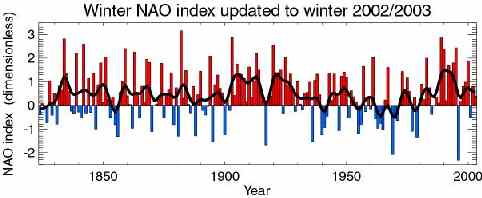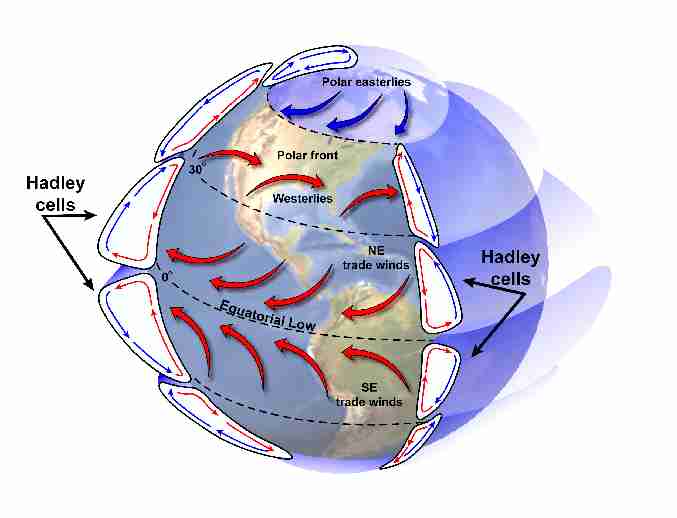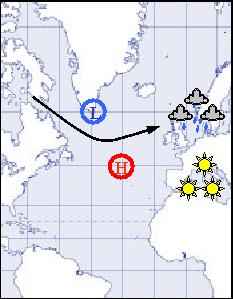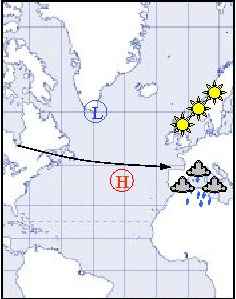 > English > Climate Encyclopaedia > Oceans > more > 1. Oceans and climate > - North Atlantic Oscillation
> English > Climate Encyclopaedia > Oceans > more > 1. Oceans and climate > - North Atlantic Oscillation
|
The OceansRead more |
The North Atlantic OscillationThe North Atlantic Oscillation is one of the oldest recognised weather patterns. It governs whether winters in northern Europe will be wet and warm or cold and dry. We don't really know what controls the North Atlantic Oscillation and we don't know whether it is likely to be influenced by climate change.
|
Atmospheric PressureAir pressure at the Earth's surface is different in different places and this is partially due to the different amounts of heat they receive from the sun. When the Sun heats up the earth, the air above warms, becomes less dense, expands and rises. The air above is pushed upwards and then spreads out horizontally at height in the troposphere. Because of this horizontal air movement there is less air above the ground where the heating took place and this leads to an area of low pressure. As the air rises, it cools. As it cools, the air becomes more dense and sinks. This sinking means that there is more air above the ground in this area and a region of high pressure is formed. Air moves from high pressure areas to low pressure regions to even out the pressure differences, generating winds and atmospheric circulation as a result.
|
The North Atlantic OscillationPressure differences between the Azores at ~30oN and Iceland at ~60oN result in one of the oldest known natural weather patterns, the North Atlantic Oscillation (NAO). The NAO is most important in winter and has two phases. Each causes distinct weather conditions around the North Atlantic. Agricultural harvests, water management, energy supply and fisheries are all directly affected by the phase of the NAO. It even governs where new deep water is formed and therefore influences the thermohaline circulation.
|
 |
|
2. This figure shows the North Atlantic Oscillation Index over the past 200 years. Up until around 1900, the NAO index seemed to change almost every year but since then it appears that the NAO index has been predominantly positive leading to warm wet winters in Northern Europe. We don't know whether this change is simply natural climate variability or whether numan influence through global warming has changed how this natural climate phenomenon operates. Thanks to Dr. Tim Osborn at the Climatic Research Unit, University of East Anglia, Norwich, U.K. for use of this figure. |
Positive NAO conditionsPositive NAO winters occur when there is a very large pressure difference between the Azores and Iceland. This results in more and stronger winter storms crossing the Atlantic travelling in a northeasterly direction. These bring heat from the ocean to northwestern Europe leading to warm and wet winters here but cold and dry winters in the Mediterranean region. Strong northwesterly winds travel over the Labrador Sea causing cooling, resulting in the formation of new deep water and cold dry winters in Canada and Greenland. These winds don't make it over the Greenland Sea so this region doesn't cool so much, reducing deep water formation here.
|
Negative NAO conditionsNegative NAO winters occur when there is only a small pressure difference between the Azores and Iceland. This leads to fewer and weaker winter storms. These storms follow a more southerly track than those associated with positive NAO conditions and bring warm moist air to the Mediterranean. They also allow cold air from the north and the east to blow into northern Europe. This cold northerly wind travels from the North Pole over the Greenland Sea cooling the water enough for it to sink and form new deep water here. |
|
|
What controls the NAO?We still really don't know what controls the phase of the NAO. Processes which are controlled just by the atmosphere occur over time periods of seconds to weeks. The phase of the NAO, however, changes over years to decades. This suggests that the ocean as well as the atmosphere is an important control. Computer models suggest that the NAO responds to slow changes in global temperatures with changes around the equator appearing to be most important. Winds high up in the stratosphere may also affect the climate of the North Atlantic. Climate changeThe NAO is an important topic in climate change. The phase of the NAO has been consistently more positive recently leading to mild winters in northern Europe and we really don't know why. It may be that this is simply natural climate variability or that global warming is changing how the NAO and other natural climate variations work.
About this page:author: Dr. Lucinda Spokes - Environmental Sciences, University of East Anglia, Norwich - U.K.
|



